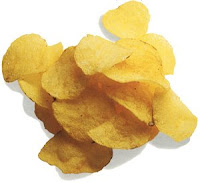The Soggy Potato Chip (negative attention)
The last blog was about the slot machine. This one is on the
soggy potato chip.
I imagine you’re starting to think I’m nuts right?! Read on.
This is one is THE HARDEST but can be THE MOST FRUITFUL if you actually DO
IT!
Ok. This theory is that the soggy potato chip is not the delicious crispy chips (pic on left),
but the soggy chip is still better than no chip at all, especially when you're hungry. We’ve all experienced this stale
chip at the beach or pool, and we eat it. How does this relate to managing our
child’s behavior? Well, negative or bad attention is better than no attention.
Soggy is better than none. To your attention maintained child, attention from
you is the most important thing to him in the entire world!!!! The best
attention is the good kind (praise, rewards, your smile at him). Unfortunately,
the next best thing is bad attention. Bad attention means getting yelled at or
being told not to do something. Oh DARN you say. This happens daily. Well, yes.
Just begin to be aware of it. If your child has been playing well quietly while
you check facebook or make dinner (and you’re keeping quiet because they’re
being SOO good), then out of nowhere, they choose to misbehave. The crayons are
on the wall or the juice is wiped all over the sofa. Why? THEY GET YOUR
ATTENTION! If they stay quiet and “good,” they’re not getting any! He may be
scolded and have to help clean, but it is ATTENTION.
I’m guilty. You’re guilty. What do we do now????
Don’t put your kid in this position in the 1st
place. Instead, catch your child being good!!! Give extra attention when he is
playing well, putting the spoon of food in his mouth & not flinging it,
putting toys away. He won’t need to have you respond with the negative
attention or soggy chip!
Ok some parents tell me that this interrupts their kid
playing well and the kid becomes more demanding and stops playing nice. Should
this happen, be calm and firm. Tell him you need to do something else, but
you’ll be right back to check on him (praise him for being good). Consistency
(not the slot machine approach) will lead to improved behaviors overall, less
attention seeking for that bad attention, and more attention seeking with
positive behavior!
Good luck! (p.s.- you can also try this with your co-workers)
(The chip analogy was inspired by Jodi Mindell (see last
blog). Love her!)




